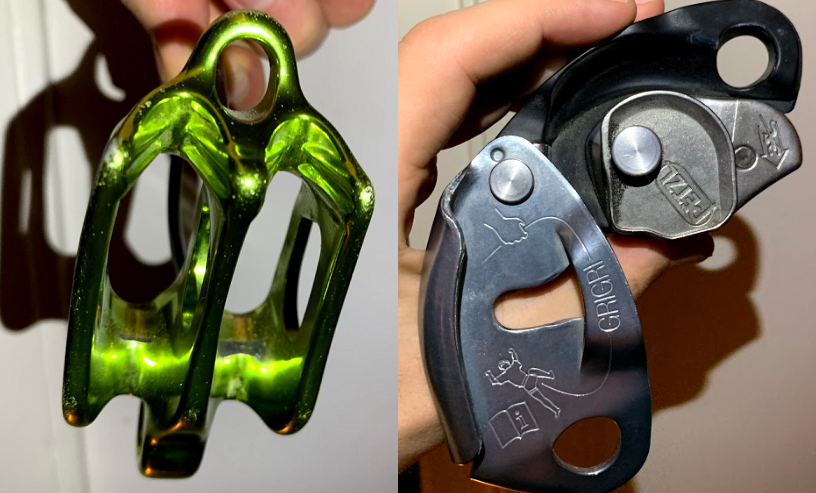The introduction of the GriGri revolutionized the rock climbing industry in the 1990s.
Because of its ability to instantly lock and protect climbers in the case of a fall, GriGris have been lauded as the safest option on the market.
Indeed, you may have noticed that a majority of rock climbers now invest in this product.
And the reasons are clear: because of its autolocking abilities, the GriGri leaves less to chance. Many find that this added protection makes the GriGri worth their investment, but there are still others who prefer to use old-fashioned ATCs.
So which one should you choose?
This debate is one that pits innovation versus tried-and-true methods, and it’s one that both has and lacks a true winner all at the same time.
How?
Allow me to explain.
Below, I’ll walk you through what you need to know to choose between these two great devices.

Which One Is Right for You?
To begin with, it must be noted that the most important consideration you can make is how comfortable you are with the belaying device.
If you’re just starting out with rock climbing and don’t already have a preference, then you may choose to learn one or the other. The information contained in this article can help you make the best choice for your safety.
However, if you’re one who has extensive experience using one or the other of these two types of equipment, it can be a more difficult decision.
Let’s be honest.
Those who still use ATCs are sometimes the subject of criticism from those who use GriGris.
By opting to use a device without an automatic locking feature, they say, those who use ATCs are putting climbers at unnecessary risk.
Basically, a large section of the GriGri camp does not wish to subject the lives of their climbers to human error.
But the reality isn’t quite so black and white.
As any serious climber will tell you, it’s much more dangerous to use equipment you’re not familiar with.
Case in point: if you’re familiar with using an ATC and not a GriGri, you shouldn’t attempt to make your next climb using a GriGri. It’s simply not safe.
Though you may be reducing the risk of human error in some regards, the updated technology of the GriGri cannot overcompensate for your lack of experience.
The thing most people don’t want to hear is that the GriGri doesn’t solve everything.
It can’t magically fix incompetence.
Instead, it can reduce the likelihood of and prevent accidents when used by those who are familiar with them.
For this reason, they are a great choice of equipment for those choosing to learn; however, forcing an individual to belay with a GriGri when he doesn’t have the proper understanding or training can prove deadly.
With this in mind, it stands to reason that in order to enjoy as safe a climb as possible, one must belay only with the device they’re most comfortable with.
ATC users will probably rejoice at this information, and that’s okay.
But let me make it clear that I’m not pushing one of the alternatives over the other.
There are times when each is better suited to a certain role, and it’s important that you have an understanding of this when choosing your belaying device.
You may even think it prudent to familiarize yourself with both so that you can get the most out of your climbing experience.
If you’re just starting out or are looking to make a change, it’s important that you know everything there is to know about these two devices.
For this reason, I’ve separated this information into separate categories and analyzed the performance of both devices under each one.
Additionally, I’ve provided my opinion about which one is better to get the job done. As you read the information, however, feel free to come up with an opinion of your own.
Remember: at the end of the day, what’s really going to matter is how comfortable and well-versed you are with a particular piece of equipment.
With that in mind, let’s take a closer look at how these two devices perform in different circumstances so that you can get started choosing the one right for you.
Indoor versus Outdoor Use of the ATC and GriGri
One of the most important factors influencing your decision should be whether you intend to use the device for indoor or outdoor use.
As you will see, there’s little difference in quality and safety when using these devices indoors, but if you plan on taking your climbing outside, one has a clear edge.
When climbing indoors, both provide the functionality belayers need to keep their climbers safe.
The autolocking feature on the GriGri, however, makes it better suited for outdoor use.
Now, this isn’t a statement that everyone will readily agree with.
Why?
Because ATCs lack an autolocking feature, they don’t weigh quite as much as GriGris.
And for those in rock climbing, weight can be a big deal.
Alpine climbers, for instance, may prefer to use ATCs because their lower weight. This can help them navigate and move for longer periods without experiencing fatigue.
However, it’s important to remember what’s being sacrificed in order to achieve this lighter weight: safety.
While both are reasonably safe in the hands of skilled belayers, a head-to-head comparison of the two devices when being used by competent belayers will show you that GriGris can simply do more to protect climbers.
This is especially important if you’re climbing outdoors.
You’re likely going to want the added safety that the autolocking feature brings to the table.
Because let’s face it: everyone gets distracted at times.
And if you’re a beginner rock climber, this can be even more of an issue. You’re going to want to have a safety net just in case your belayer messes up.
Because mistakes happen even to the best of us.
Remember, a GriGri isn’t going to magically guarantee your safety, but it’s added layers of protection can do more to keep you from harm in the event of an emergency.
Why does this matter?
Because if you’re climbing outside, you’re subject to harsher conditions than you would face indoors. You also have greater distractions, and the thrill of making outdoor climbs can lead to feelings of greater anxiety.
All of these can line up and start making your climb more dangerous than it truly needs to be.
By investing in a GriGri, you can climb with added peace of mind that you’re not doomed in the event that you do fall.
Additionally, this feature can help make sure that your belayers aren’t doing as much work. This will allow them to stay more focused and energized.
All of this makes it clear that GriGris are better suited for outdoor use.
If you’re looking for a lightweight climb, however, ATCs should be your go-to. Just remember that you’re sacrificing your safety in order to have more lightweight gear.
One last thing of note is that the GriGri may provide more versatility in the types of climbs that you’re able to safely perform.
Though there’s no inherent reason why the ATC would limit your climbs, the GriGri’s extra security can make it better for doing things such as projecting, lead climbing, sport climbing, and route-setting.
Which has the edge?
The Grigri.
Variety and Price
When it comes to variety, these two products come in at a dead tie.
Both have two main models, meaning that there’s not a lot of variety for customers to choose from.
The good news is that all four models provide solid reliability and can be safely used to climb.
Let’s take a look at the different models for each.
- GriGris—GriGris come in the form of the original GriGri and the later GriGri 2. The GriGri 2 boasts several improvements over the original model. Namely, it’s much smaller and lighter, giving climbers better flexibility to make the climbs they need.
In fact, the GriGri 2 has been shown to be as much as 25% smaller and 20% lighter than its predecessor.
It’s also more expensive.
The GriGri 2 currently retails for around $80 – $120 (€70 – €105). The extra price is worth it for those looking to get the most out of their belaying device.
- ATCs—ATCs come in two main varieties, as well. The ATC-XP and the ATC-Guide have one major advantage over the GriGri and the GriGri 2: their price.
In fact, if you’ve looked into getting either device, you’re probably aware that both only retail for around $20 (€17.5).
The two products have different functionalities. The Guide, for instance, features an extra loop that allows for belaying from the anchor while in an autoblock setup. It’s also designed for best use with ropes that are a bit thicker—while the XP has been shown to be more effective with ropes of the thinner variety.
As you can see, you have a number of solid options to choose from, no matter if you’re choosing the ATC or the GriGri.
Keep in mind that while the ATC is the better option for those on a budget, the extra cost from the GriGri stems from the fact that it boasts a safer autolocking system.
Which has the edge?
It’s a tie.
Safety: GriGri versus ATC
Without a doubt, the GriGri is the safer of the two options.
Think about it this way. If your belayer got smashed in the head by an unexpected falling object, which device would you prefer him to be using.
That’s what I thought.
The assisted braking system on the GriGri protects climbers from serious injury in case of sudden or unexpected falls.
Let’s face it: no matter how good your belayer is, he won’t always be able to protect himself in case of an accident. That’s why it’s important that you have secondary support to ensure your safety in the event of an accident.
With the ATC, belayers must be attentive at all times. And if a rock does hit your belayer in the head, you had better be ready for a sharp fall. This is the most obvious downside to the ATC, but it’s a huge one.
Ask anyone who’s ever fallen.
Which has the edge?
The GriGri.
Best for Beginners
If you’re just getting into climbing—whether in the gym or outdoors—it’s important that you learn the proper technique to facilitate safe and enjoyable climbing.
For this reason, I’m thoroughly convinced that the ATC is the better option for beginners. Sure, it may require more manual work, but that really only proves my point. If you are just starting to climb, you don’t want to take any shortcuts. You never know when that thing you skipped out on will come back to haunt you.
Of course, in this case, I’m talking about the GriGri’s assisted braking system. If you learn using the GriGri, you may get too comfortable. Say you are out climbing one day and you don’t have access to this type of convenience.
What will you do?
Chances are, you’ll be put in a tough situation. And between you and me, falling and sustaining injuries in an accident because you and your belayer are unfamiliar with the proper belaying system doesn’t exactly sound like a good time.
If you learn with the ATC, however, you won’t have access to this assisted braking feature. This means that you will have to work closely with the belayer in all situations. In this case, communication is the key. Only after you are comfortable navigating a climb this way should you consider climbing with more technological options.
Either way, you should always work with a belayer who is familiar with your current device. A GriGri might seem safer than a traditional ATC device, but that’s only the case if your belayer is familiar with the system.
What’s more, studies have proven that the ATC offers a better catch. What I mean by this is that you won’t experience many sudden or jerky falls with the ATC. While the assisted braking system on the GriGri is nice, it offers a shockingly-more intense fall, which may be off-putting for beginners.
To sum it up, the ATC is the better system for beginners, even if it’s only because it’s the tougher of the two systems to navigate. To further justify my belief, the ATC is the less off-putting of the two when it comes to sudden falls. Finally, proper use of the ATC enhances good belaying habits and allows for users to get the hang of rock climbing.
Which has the edge?
The ATC.
Best for Advanced Climbers
For advanced climbers who are familiar with both systems, I’d have to give the edge to the GriGri.
Why?
Not only is it the safer of the two options, as we discussed, but it’s also suited for more uses. While the ATC performs well in the gym, it’s not as suitable for sustained or frequent lead climbing as is the GriGri. Of course, both systems function well with multipitch climbing, but the ATC is outperformed in certain aspects, including projecting, simulclimbing, and routesetting.
This gives the advanced climber the freedom and security to perform more daring climbs. Simply put, it’s much easier to scale a difficult wall if both your belayer and your system are top-notch.
That’s not to say that ATC aren’t top-notch items; it’s simply to say that they don’t do as much.
And when your belaying device doesn’t offer as many climbing options and doesn’t keep you as protected, it’s easy to see why the GriGri has become such a popular option.
Which has the edge?
The GriGri.
Best for Belayers
As with the other options on this list, the choice here is obvious.
In short, one requires the belayer to be on guard in the case of sudden or unexpected falls and the other does not.
While it’s certainly the case that the belayer should be on guard no matter what system is being used, GriGri allow belayers to take a bit of a rest. With the GriGri, the belayer doesn’t have to do as much legwork while the climber hangs. Instead, the cam will do most of the work.
With ATC, however, the belayer must be providing tension. Not only does this make the job harder and more stressful, it increases the chance of risk. Ask any belayer who’s been doing most of the legwork for an extensive climb.
It can get exhausting.
It’s important that you have a backup system for when your belayer starts feeling the effects of fatigue. With the GriGri, the belayer experiences far less stress, and this is beneficial for two reasons. Not only do you want your belayer to be in tip-top shape for your own personal safety, but you won’t be able to make extensive climbs if your belayer is too fatigued.
For these reasons, it’s only logical to choose the GriGri as the superior option in regard to belayers. While some belayers may take offense to this, it shouldn’t be an affront to anyone’s skills or pride to say that a little extra security is always a good thing.
Which has the edge?
The GriGri.
Comfort: ATC versus GriGri
While it may not seem like much of a big deal, comfort is heavily considered by many serious rock climbers. You certainly don’t want to climb up a rock wall if you’re uncomfortable—if you know what I mean.
Because of this, it’s important to stack the GriGri and the ATC against each other in terms of comfort.
As I’ve already pointed out, the ATC is much lighter, and as such is the device of choice for many alpine climbers. But outside of weight, are there any factors working in the ATC’s favor?
As it turns out, the two devices seem about even. For example, most climbers remark that while the GriGri may sometimes offer harder falls, hanging is much more comfortable.
It’s also easier to pause in the middle of your climb while you are using a GriGri. If you are routesetting and need to take a small break, this is easily possible with the GriGri. Not only do you have the option to relax a bit, but so does your belayer.
In these regards, the GriGri is certainly a more comfortable (and convenient) option. The ATC’s light weight and soft falls cannot be ignored, however.
For this reason, I’ve chosen to tie the two products. Though I lean more toward the GriGri myself (as might most lead climbers), it’s really up to the individual to find out which device is more comfortable for him.
Which has the edge?
It’s a Tie.
The Bottom Line
Both the ATC and the GriGri are established belaying devices that all rock climbers should be familiar with.
That being said, it’s inevitable that serious rock climbers will have a system of choice. Because of this, we’ve decided to answer the age-old debate of which device is better for rock climbing and list out specific reasons why.
In our study, we looked at various components of the two devices to weigh the specific pros and cons for each. Overall, we found that while the ATC outperformed the GriGri in specific areas (such as weight and beginner use), the GriGri is overall the better system.
This is the case for a variety of reasons. First, the device is simply safer. When you are climbing, safety is always the number one concern. For this reason alone, the GriGri should be considered the device of choice for serious rock climbers.
In addition to this, however, the GriGri also offers other benefits, such as superior outdoor use and belayer ease of use.
With that being said, however, it’s really up to the individual to find the device that’s best for him. Remember: no matter which system looks better on paper, it really depends on what you and your belayer are most comfortable with.
In other words, it doesn’t matter how nice your system is if you can’t use it correctly.
That’s why I suggest a familiarity with both systems if you plan on being a serious rock climber. Knowing how to navigate both devices can help prepare you for any situation. What’s more, even if you have a preference, it’s always nice to have a bit of backup.
I hope this guide helps and answers your questions. Remember, no matter what device you choose, you should always follow all safety protocol to ensure safe and fun climbing.






